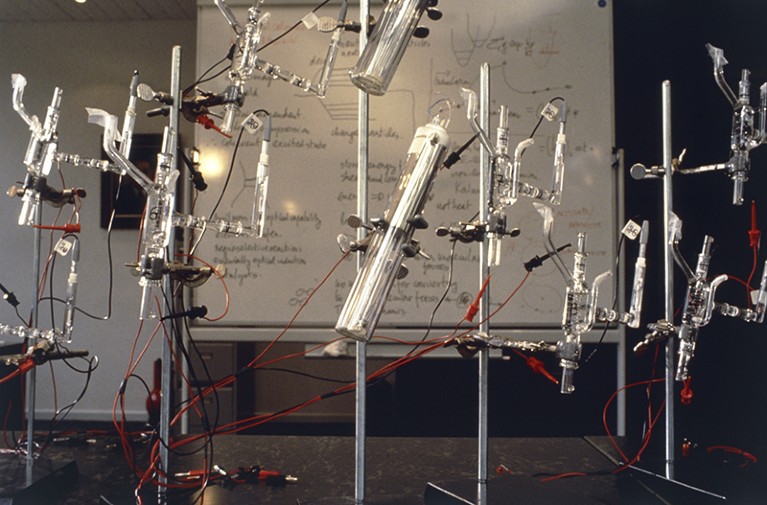
A 1989 claim that nuclear fusion could be induced using bench-top apparatus caused a storm of controversy.Credit: Philippe Plailly/SPL
Thirty years ago, claims of ‘cold fusion’ hit the headlines, promising a solution to the apparently impossible dream of producing cheap and clean energy using little more than standard bench-top apparatus. From the outset, it sounded too good to be true.
Fusion of atomic nuclei is typically associated with high-energy astrophysical environments (the Sun, for example). So when researchers at the University of Utah in Salt Lake City asserted in early 1989 that they had induced the process by passing an electric current through a simple electrochemical cell, it drew scepticism straight away. The phenomenon — even if real — seemed ephemeral and had little to no theoretical basis. Many groups failed to repeat the findings. The episode is now largely remembered as a case study in confirmation bias. Discussions of the phenomenon are relegated to the fringes of mainstream scientific discourse, and for years it has received little serious attention.
Until 2015, that is, when Google convened and funded a group of around 30 researchers spanning several laboratories to take another look. After all, absence of evidence is not the same as evidence of absence. Society’s need for cheaper and cleaner sources of energy is more pressing than ever, and, if cold fusion were possible, it could be a disruptive technology with a world-changing pay-off.
The goals of the Google team were simple to state, but challenging to execute: to develop a series of rigorous experiments and reproducible protocols that would tightly constrain the conditions under which cold fusion can be realized; and, if the team could detect the phenomenon, to develop a definitive reference experiment that would benchmark it for the wider academic community to scrutinize and verify. The programme is described for the first time in a Perspective, a technical opinion piece.
The team found no evidence whatsoever of cold fusion.
Is that the final nail in the cold-fusion coffin? Not quite. The group was unable to attain the material conditions speculated to be most conducive to cold fusion. Indeed, it seems extremely difficult to do so using current experimental set-ups — although the team hasn’t excluded such a possibility. So the fusion trail, although cooling, is not yet cold, leaving a few straws for optimists to clutch on to.
The question now is whether it is even worth continuing this research. Here, the message is more nuanced. The project has produced materials, tools and insights — such as calorimeters that operate reliably under extreme conditions, and techniques for producing and characterizing highly hydrided metals — that could benefit other areas of energy and fusion research. But whether the spin-off benefits alone justify continued efforts and investment in pursuit of a probable pipe dream is another matter. Opinions are split.
So what do we take home from a multi-year failed experiment? First, that the programme has been conducted with rigour and attention to detail — we can have confidence in the results. Second, although the work provides no support for fringe groups that continue to insist that cold fusion exists, it does bring this research area back into the light of harsh scientific scrutiny. And, by doing so, the project might help responsible research in this general area to become less taboo, even if the chances of achieving cold fusion still look extremely remote.








